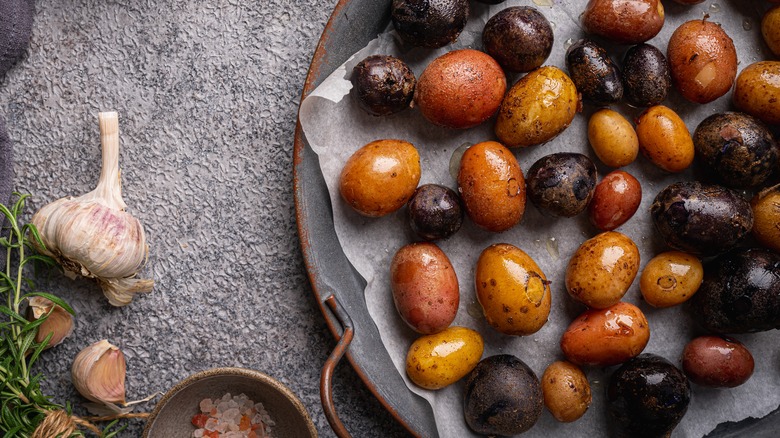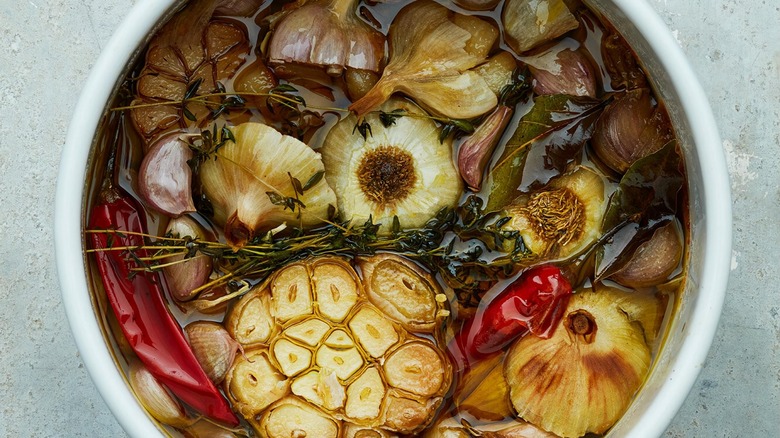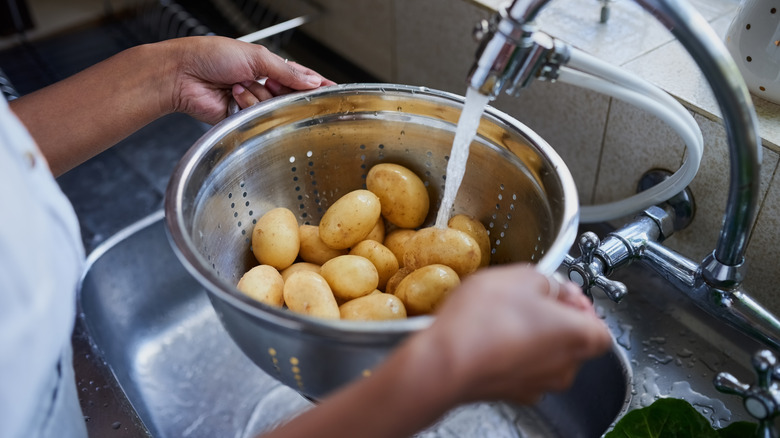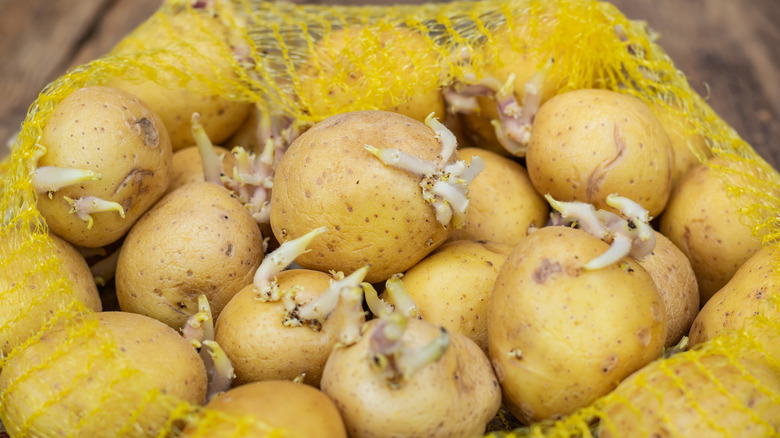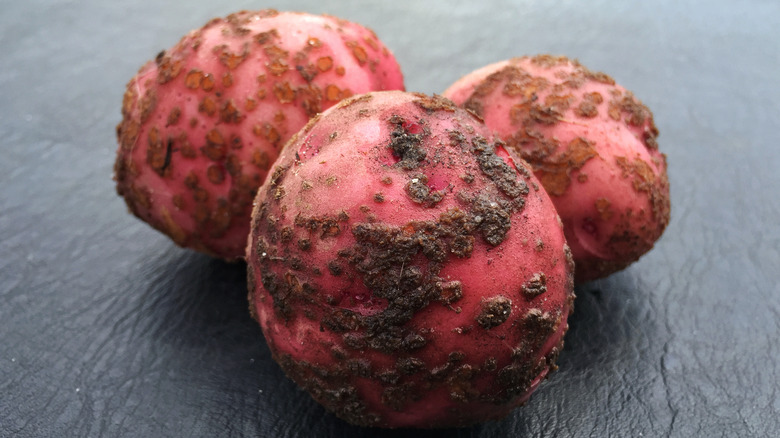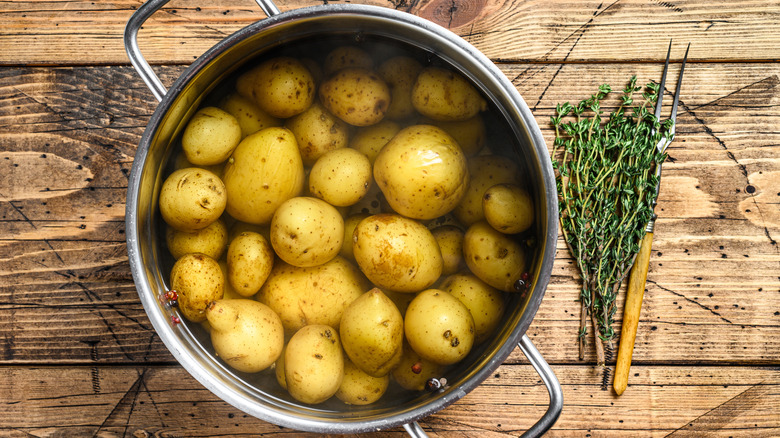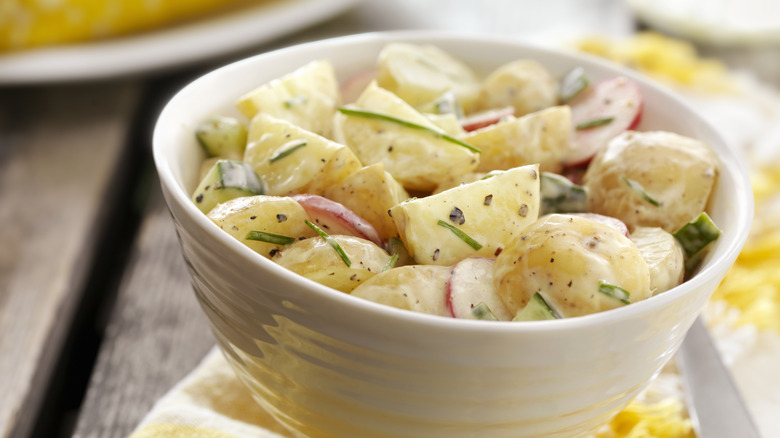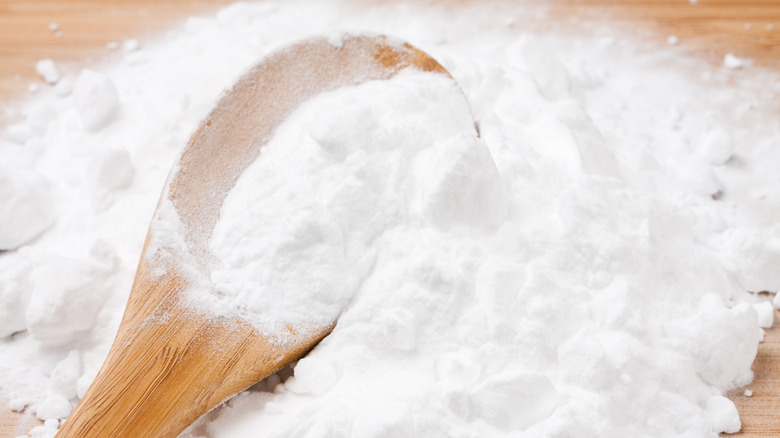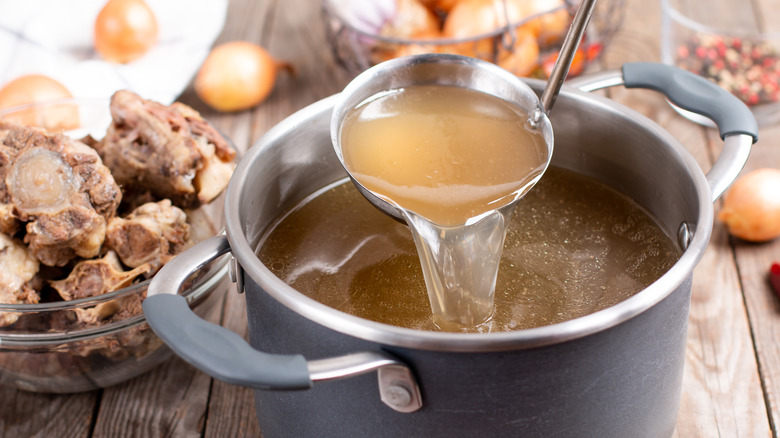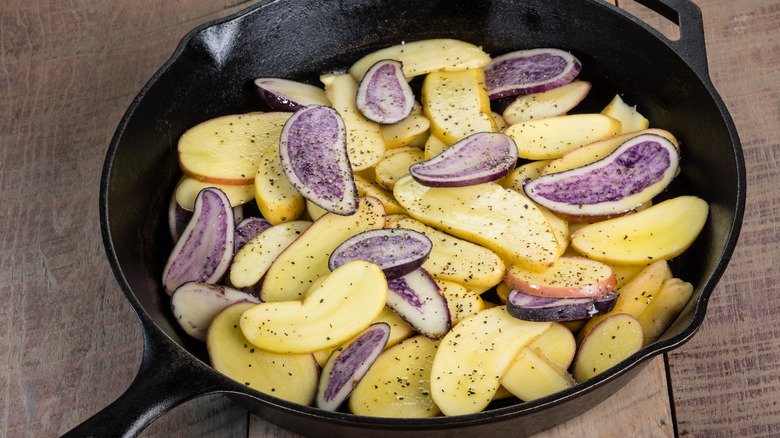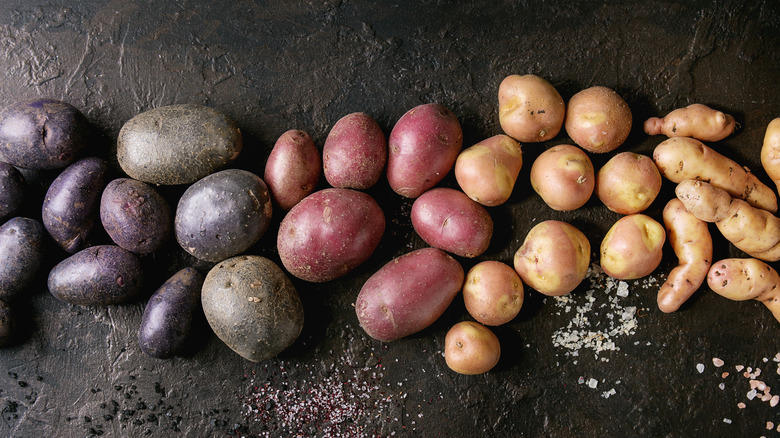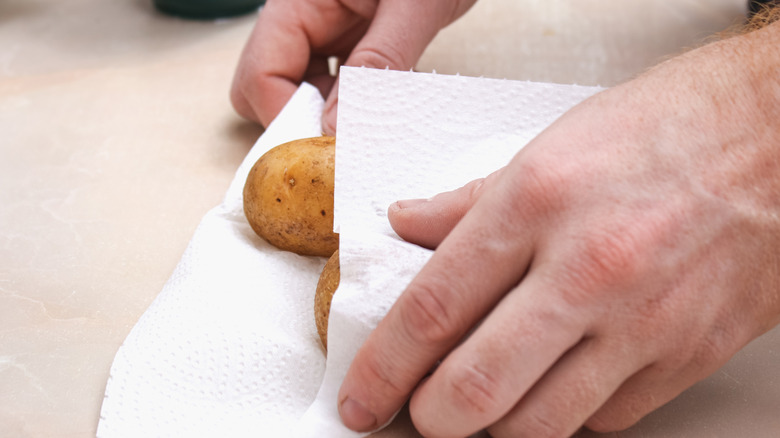11 Tips You Need When Cooking Fingerling Potatoes
One of the most important ingredients in the culinary world, the potato is a starchy plant native to South America. They have been cultivated for thousands of years, starting with the Incas and expanding into Europe in the 1500s. Since then, they have been featured on menus across the globe and in home kitchens everywhere. There are over 4,000 native varieties of potatoes, but the most popular are a few grocery store staples of starchy and waxy potatoes, from Idaho to Russet, red to fingerling.
Starchy potatoes are great for the classic baked potato with all of the toppings, or creamy mashed potatoes with chives. Waxy potatoes shine when roasted or boiled, hot or cold. Fingerling potatoes are a type of waxy potato that have their own plethora of varieties. The most popular is the Russian Banana, a yellow, curved potato with a lovely mellow flavor and an abundance of cooking options. Their buttery and creamy flavor along with their unique shapes and colors makes them an excellent choice for your next potato-based meal.
Fingerling potatoes excel when they are at their best physical quality and preparation. Their shape, size, and type lend them to specific techniques that can really make them shine. Due to their versatility, it may seem daunting to choose a method or recipe when preparing these tubers. Although the possibilities seem endless, there are a few things to look out for before honing in on a dish.
Confit them in fat or oil
If you want to impress dinner guests, go for the classic French confit. Traditionally a preservation technique, the confit process is a method of preserving food by salting and cooking ingredients low and slow in fat. There are a few ways to confit, with options like sous vide, to cook at 200 degrees Fahrenheit for three to six hours, or to heat on a low flame without letting the melted fat bubble. Poultry is a commonly confited ingredient, with duck confit being a popular dish, but vegetable confit is also common, like garlic or tomato confit.
Fingerling potatoes work well for confiting because they will maintain their structural integrity when cooked in fat or oil. Starchier potatoes are prone to crumbling. Fats typically used for confiting are duck, goose, or chicken fat, but olive oil is a viable option as well. As the potatoes cook in the fat, they become incredibly tender. You can also infuse the fat with aromatics and spices to further develop flavor, and the confited fat can then be reused by straining it of its impurities. Use it to roast more veggies or as a replacement for butter or oil when cooking. It is liquid gold.
Wash before cooking
Even if you plan on peeling your potatoes, it is still important to rinse them beforehand. The part of the potato plant that we eat, known as a tuber, is grown completely underground. The potatoes we see at the store likely have dried dirt or residue on their skin, and that dirt can carry bacteria or pesticides that remain on the outer layer of the potato. If you don't wash them before cutting or peeling, that bacteria can end up transferring onto the interior flesh of the potatoes. Even if a potato looks clean, there is still bacteria present on the skin.
When washing your potatoes, soak them in cold water for a bit to soften up the dirt. Fingerling potatoes, and other waxy potatoes, have thinner skin than other varieties, so a brush could tear through that skin. The best way to wash them is by scrubbing them with your hands to avoid any of those unwanted tears. Make sure not to use any soaps or disinfectants when washing potatoes, because it can leave harmful residue. Cold water does the job just fine.
Remove the green spots or eyes
When choosing potatoes at the grocery store, fingerlings are often sold in bunches. Instead of grabbing one and going on your way, it's worth taking a few moments to give the potatoes a quick scan over to ensure there isn't an excessive amount of sprouting or green spots. Sometimes potatoes have small sprouts protruding from them. These are called "eyes" and they are the beginnings of a new potato plant. Potatoes with eyes can still be used if they are firm to the touch, but the eyes should be removed, as they impart a bitter taste when cooked. If a potato with sprouts has softness or shriveling on the skin, it's likely too late to consume. All is not lost though, because you can plant the sprouts to grow a new plant.
When it comes to green spots or overall green coloration on the potatoes, it is best to avoid them. The green shade that develops on potatoes is chlorophyll, produced by the skin cells due to prolonged light exposure. The skin cells of the potato also produce toxins that can cause sickness in consumers. If a potato has a small green spot or two, it is safe to cut out. However, if you have small children, it is best to avoid potatoes with green spots altogether, because they have a higher chance of being affected by the toxins. Storing potatoes in a cold, dark, and dry place helps to slow down the development of green spots and sprouting.
Avoid potatoes with cuts or scars
When choosing potatoes, it is important to pick ones with no signs of spoilage. Many grocery stores have stacks of potatoes, so there should be plenty to choose from. Some may have deeper cuts that have browned over and dried up, or scars with dark spots. Tiny impurities are inevitable, but it is better to skip the potatoes with excessive blemishes. Since fingerling potatoes have thin skin, they are more susceptible to damage, and bruises and scars can decrease the shelf life of the tubers. Black spots on potatoes are typically from internal bruises and thus are harmless. On occasion, black spots can be signs that the potato is starting the decaying process.
Scab-like patches are also something to look out for, as they are a symptom of potato scab, a common disease in potatoes. Potato scab affects potatoes with thin skin, like fingerlings, more often. Scabby tubers are still edible when peeled, but they have the potential to develop decay from soft rot bacteria, in which case they cannot be consumed. Fingerling potatoes that come in bunches will likely have one or two blemished potatoes, but once you know what signs to look for, you'll be all ready for your meal.
Boil or grill for optimal flavor
When it comes to boiling potatoes, if this is the one and final stop in the cooking process, using a potato that maintains its structural integrity is crucial. Starchy potatoes crumble more easily due to their high starch content and low sugar and moisture levels. Fingerling potatoes are waxy, so they have a low starch content with high moisture levels. This allows them to maintain their shape even after boiling. Therefore, fingerlings are the best option when serving simple boiled potatoes with seasoning.
Fingerling potatoes are also a great side dish if you are looking to go outside and cook on the grill. Their small size allows them to cook through easily. Waxy potatoes work well on the barbecue, and they are commonly cooked sliced in half and placed on foil. Alternatively, they can be cooked whole, rubbed in oil, pierced with a fork, and then wrapped in foil and roasted. The grilled potatoes will develop a smoky flavor that is unmatched. Feel free to throw in some garlic or shallots for extra flavor. A Dijon dressing, balsamic, or fresh herbs really elevate the creamy fingerlings once off the grill. They pair well with grilled corn , a summer salad, or homemade burgers.
Use in recipes that seek intact potato chunks
The benefit of cooking with waxy fingerling potatoes is their thin skin and ability to stay together without crumbling. Although they wouldn't work well in recipes like mashed potatoes or creamy potato soup, they work great in recipes that look for solid, intact potato chunks or slices. An excellent way to make use of all of the fingerling varieties is in potato salad. The overall small size of the fingerlings and their varying shapes and skin colors can offer a pop of vibrance to any potato salad.
Adding fingerling potatoes to soups is a good choice because they won't break down and thicken the broth. The potatoes don't need peeling and have a smooth, buttery flavor profile and consistency that will elevate your soup to a new level. If going the roasting route, the small size of fingerlings allows for an easier allocation of portions, and they can be roasted whole for those who like to meal prep. A popular recipe that uses fingerling potatoes is smashed roasted potatoes. This recipe presses boiled potatoes with a sheet pan or the back of a glass and roasts them for an extra crispy surface and a crushed-but-not-crumbled crispy potato.
Parboil in baking soda
There are tons of tips and tricks that people have created in order to make the most out of boiling potatoes. Whether it's adding salt to the water for seasoning or pouring in a splash of vinegar to prevent the potatoes from overcooking, there are a variety of possibilities to enhance the boiling process. Parboiling is a method of boiling potatoes until they are just cooked through so that they won't become overcooked once roasted or baked.
J. Kenji López-Alt, an American chef and author, explained to The New York Times that they add baking soda to the water when making roast potatoes. Adding baking soda to the boiling water creates an alkaline environment which breaks down the pectin in the potatoes and draws out the natural starches. The result is a potato that is soft and fluffy on the surface. That increased surface area from the released starch on the fingerlings allows for more of the flesh to crisp up during roasting. That starchy surface of the fingerlings, when roasted or baked, results in an extra crispy exterior and soft interior. Combining different methods can be beneficial. Adding salt to the cooking liquid along with the baking soda will provide an extra layer of seasoning to the potatoes.
Braise them in chicken stock
Fingerling potatoes have a higher moisture content than starchy potatoes, so they are better suited to being served boiled or braised, and cooking them in enriched liquid adds to the flavor of the potatoes themselves. Potatoes should be placed in cold water that is brought up to a boil. If they are placed in already boiling water, the exterior cooks before the interior gets a chance to, making for uneven texture and seasoning. Fingerlings are dense and have a high moisture content, so they won't absorb as much water as other varieties. This is why the cooking liquid must be heavily seasoned so that the flavor penetrates the potatoes.
Braising fingerlings in chicken stock is a foolproof way to infuse salty, savory flavor into fingerlings. The potatoes get seared first for a crispy exterior and then slow cooked in the flavorful stock for hours on low heat, so they will be soft and seasoned in the interior with an aromatic caramelized browning on the exterior. Braising takes a while, but it is very hands-off, allowing you to prepare other dishes in the meantime. You can elevate your dish by adding garlic cloves and herbs like thyme or sage to infuse the braising liquid. For a vegetarian alternative, try using vegetable stock or mushroom bouillon for added umami.
Sear at high heat on a nonstick skillet
Since fingerling potatoes can maintain their shape and structure upon boiling, one way to add a layer of crispiness to them before serving is to give them a quick sear on high heat. Fingerlings have unique shapes and are small in size, so slicing them in half is beneficial in providing a flat surface area for searing. Searing the fingerlings on high heat is important for initiating the Maillard reaction, which results in a crispy brown exterior and a wonderful smell that fills your kitchen.
The oil in the pan needs to be hot, and the potatoes should be placed cut-side down. Once they start sizzling, aromatics like garlic or rosemary can be added to the pan to infuse the oil and give the potatoes an extra pop of flavor. It is crucial to note that parboiling the potatoes before the searing process is a necessary step in ensuring they are fully cooked in the end. The nonstick skillet is a great pan to use for this process because the starch in potatoes can contribute to sticking. An alternative pan to use is a cast iron skillet, but it should be well-seasoned to decrease the chance of stuck-on potato bits.
Keep the skin on
Although peeling and dicing potatoes is common, fingerlings truly shine when their skin is kept on. These potatoes have a thin exterior, which isn't tough like the skin of starchy potatoes and adds great texture to any dish. There are multiple varieties of fingerlings, like the Russian Banana or Rose Finn Apple, coming in all shapes and sizes and have coloration that ranges from purple to red to golden. These would be great in recipes that look for some color, like blue potato chips or a vegetable salad.
Keeping the skin on the fingerlings has health benefits too. Potatoes have tons of antioxidants, and the skins themselves can carry nearly 12 times the amount of antioxidants present in the interior flesh. The most vibrant potatoes, like the fingerling varieties Purple Peruvian or Red Thumb, have the highest levels of antioxidants. An antioxidant-rich diet can help reduce the risk of many diseases, like cancer or heart disease, because antioxidants protect against unstable cells called free radicals. The skin also has potassium and magnesium, which can decrease blood pressure. Potato skin carries around half of the fiber of the potato itself, so keep it in your dish to reap all of the benefits.
Let potatoes dry before roasting
The disappointed moment of biting into a roasted potato, hoping for that crunch but instead being met with chewiness, is something that nobody wants to relive. If you want to achieve perfectly crispy, golden-roast potatoes that are crunchy on the outside and soft on the inside, do not skip the drying process. Since waxy potatoes have a high moisture content already, letting them dry off before roasting or baking allows the skin and exposed areas of the potato to develop a more crisped exterior. That crisp happens when the dry starch comes into contact with hot sizzling fat. If the fat isn't hot, or the potato isn't dry, the potatoes will end up tacky and soft. The extra moisture on the potatoes turns into steam when cooking, which should be avoided at all costs.
After boiling, let the potatoes cool and dry them with paper towels or kitchen towels. Some people dry their potatoes overnight to get the most moisture out of them, but this isn't necessary. Just make sure to drain the excess water in a colander and pat them dry before roasting. A good roasting tip is to preheat the roasting pan in the oven before adding the potatoes so that they instantly interact with a hot surface, adding extra assurance for a crispy finish.
